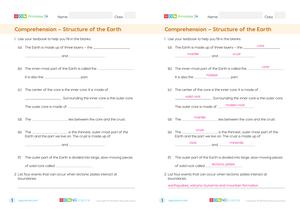Engage students with a brief discussion on what they think the Earth is made of. Introduce the concept of Earth's layers: core, mantle, and crust.
Go to the LessonLearning Objectives
- Identify and describe the three main layers of the Earth: core, mantle, and crust.
- Explain the role of tectonic plates in shaping Earth's surface and causing natural phenomena like earthquakes and volcanoes.
- Understand the concept of continental drift and how it led to the formation of current continents from the supercontinent Pangaea.
Introduction and Hook
Direct Instruction
Explain the structure of the Earth, focusing on the core, mantle, and crust. Use diagrams to illustrate the different layers.
Introduce tectonic plates and their role in shaping Earth's surface, causing natural phenomena like earthquakes and volcanoes.
Guided Exploration
Watch a video on tectonic plates and continental drift to understand how continents have moved over time.
Discuss the concept of Pangaea and how it led to the formation of current continents.
Hands-On Activity
Have students create a model of the Earth's layers using clay or playdough to represent the core, mantle, and crust.
Conduct a simple experiment to demonstrate tectonic plate movement using crackers on a layer of pudding to simulate the Earth's crust and mantle.
Independent Practice
Assign students to research a specific tectonic plate and present how its movement affects the Earth's surface.
Provide worksheets for students to label diagrams of the Earth's layers and tectonic plates.
Check for Understanding
Use a quiz to assess students' understanding of the Earth's structure and tectonic plate movements.
Try the QuizReview and Reflection
Facilitate a class discussion to review key concepts about the Earth's layers and tectonic activity.
Encourage students to reflect on how the movement of tectonic plates impacts their lives and the environment.



